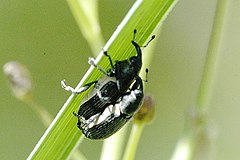Baridinae
| Baridinae | |
|---|---|
 |
|
| Mating Limnobaris t-album (Madopterini) | |
| Scientific classification | |
| Kingdom: | Animalia |
| Phylum: | Arthropoda |
| Class: | Insecta |
| Order: | Coleoptera |
| Family: | Curculionidae |
| Subfamily: |
Baridinae Schönherr, 1836 |
| Tribes | |
|
9, but see text |
|
9, but see text
Baridinae is a subfamily of true weevils (Curculionidae). It was established by Carl Johan Schönherr in 1836. Some 4,300 species in 550 genera are placed here, most of which occur in the New World. A few are economically significant pests, while others are in turn used for biocontrol of invasive plant pests. This subfamily also contains a few endangered species.
Baridinae are typically small to mid-sized short-legged weevils, with a characteristic round or ball-like shape. Usually colored black all over at least on the upperside, they are neither highly glossy or metallic, nor dull, but moderately shiny, like polished leather. Some have small dots or bands of lighter scales that can be rubbed off, in particular on the elytrae; yet again others are dusted with an irregular sprinkling of such scales. The elytrae are often decorated with neat lengthwise rows of small pits.
The pronotum is not highly arched and may be outright flattened; it has rounded corners and it is about as wide as the elytrae. The rostrum ("snout") is long, markedly curved, and directed more or less straight downwards. The antenna attach near the tip of the rostrum; they are bent in the center and have a knop at the tip, as in other true weevils. The proximal antenna segment is stick-shaped. There are 12 antennal segments.
These weevils feed on plants as larvae and imagines, mainly on the green parts. The larvae are often stem borers. Their foodplants can be found almost all over the Mesangiospermae; they are often of the cabbage family (Brassicaceae), e.g. cabbages (Brassica napus cultivars) and Rapeseed (B. oleracea). Another type of foodplant are mignonettes (Reseda), Resedaceae and thus close relatives of the Brassicaceae. Acuthopeus cocciniae is used for biocontrol of Ivory Gourd (Coccinia grandis), a Cucurbitaceae which belongs to a lineage of rosids well distant from the Brassicaceae. Some Baridinae are found on Helianthus (typical sunflowers) of the Asteraceae, which are asterid eudicots quite unrelated to the cabbage family. And Orchidophilus is particular to Epidendroideae orchids – especially Dendrobium and Phalaenopsis –, which are monocots and thus even more distant relatives of the usual Baridinae foodplants.
...
Wikipedia
